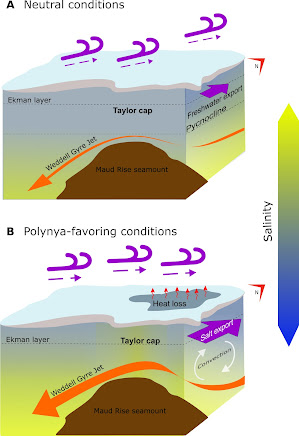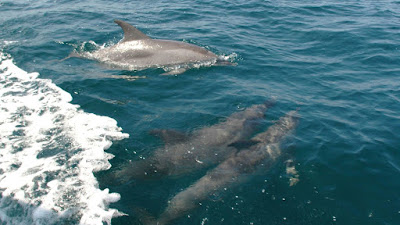Antarctica Sea Ice Mystery? The Truth Behind the Enormous Ice Gap
Scientists have discovered evidence for the open-ocean polynya formed over the Maud Rise, in the Wendell Sea, during the winters of 2016-2017. The study reveals the key process on how the polynya was able to form and persist for several weeks.
The team of researchers from the University of Southampton, the University of Gothenburg and the University of California San Diego studied the Maud Rise polynya. They found that the polynya was brought on by interactions between the wind, ocean flow and geography resulting in vertical missing of the heat and salt towards the sea surface.
Polynyas are openings in the winter sea ice that act like giant vents, exposing the warm water below to the freezing air above. Coastal Polynyas are regular visitors along the Antarctic coast where strong winds push sea ice away from the land, creating open water. Open-Ocean Polynyas are rare events that occur in the middle of the Southern Ocean. They are often linked to changes in the ocean's saltiness, which can trigger deep-water mixing.
Aditya Narayanan, a Postdoctoral Research Fellow at the University of Southampton, who led the research, said: "The Maud Rise polynya was discovered in the 1970s when remote sensing satellites that can see sea ice over the Southern Ocean were first launched. It persisted through consecutive winters from 1974 to 1976 and oceanographers back then assumed it would be an annual occurrence. But since the 1970s, it has occurred only sporadically and for brief intervals. 2017 was the first time that we've had such a large and long-lived polynya in the Weddell Sea since the 1970s."
In 2016 and 2017, the powerful ocean current circling the Weddell Sea got a boost. This wasn't just a ripple effect. The stronger current caused a surprising consequence: a deep layer of warm, salty water rose closer to the surface. This rise made it easier for both heat and salt to mix upwards, potentially affecting the entire water column.
Fabien Roquet, a Professor in Physical Oceanography at the University of Gothenburg, and co-author of the research, said: "This upwelling helps to explain how the sea ice might melt. But as sea ice melts this leads to a freshening of the surface water, which should in turn put a stop to the mixing. So, another process must be happening for the polynya to persist. There must be an additional input of salt from somewhere."
A combination of remotely sensed sea ice concentration data, in situ observations from autonomous floats and tagged marine mammals, and a high-resolution ocean model were utilized. Analysis revealed that the intensification of the Weddell Sea Gyre during 2016-2017 was due to the formation of turbulent eddies. These eddies, characterized by strong vertical motion, transported saline water from the deeper layers and deposited it on the summit of Maud Rise.
Ekman transport, a wind-driven phenomenon that causes surface currents to deviate at a right angle to the wind direction, subsequently played a critical role. Ekman transport acted to advect the accumulated salt from the summit of Maud Rise northward, leading to a pronounced salinity anomaly on the northern flank. This region with elevated surface salinity coincides with the location of the observed polynya formation.
"Ekman transport was the essential missing ingredient that was necessary to increase the balance of salt and sustain the mixing of salt and heat towards the surface water," says co-author Professor Alberto Naveira Garabato, also from the University of Southampton.
Professor Sarah Gille from University of California San Diego, another co-author of the research said: "The imprint of polynyas can remain in the water for multiple years after they've formed. They can change how water moves around and how currents carry heat towards the continent. The dense waters that form here can spread across the global ocean."
Professor Gille added: "For the first time since observations began in the 1970s, there's a negative trend in sea ice in the Southern Ocean, which began around 2016. Before then it had remained somewhat stable."




Comments